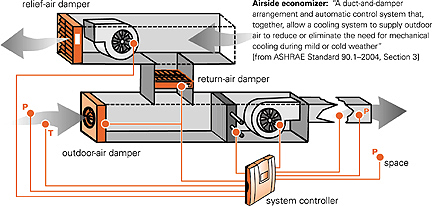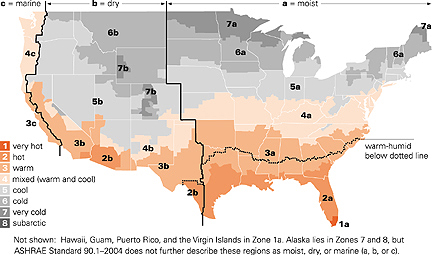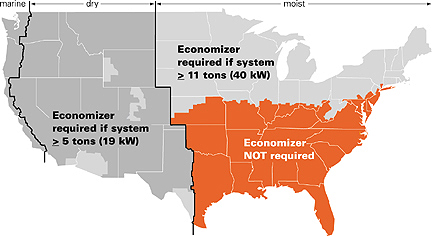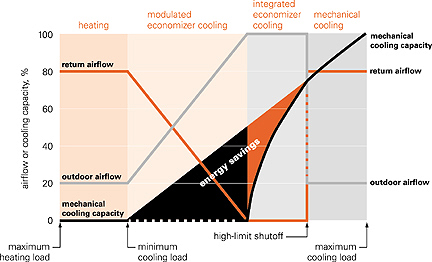Using outdoor air to help cool a building isn't a new concept. Thanks to energy standards and local building codes, it's no longer optional in many areas, either.
This article reviews ASHRAE Standard 90.1's requirements for airside economizers and discusses the underlying design decisions and benefits of effective airside economizer systems.
You're in your kitchen on a beautiful, breezy fall day, with a pie baking in the oven. Would you rather cool off the kitchen by opening your windows or by turning on your central air conditioner? By opening the windows, of course! Why? If the outdoor air is cool and dry, it can cool the space nicely without using electricity for compressors and fans, and it ventilates the space with fresh outdoor air in the bargain. The same logic holds in nonresidential buildings. In fact, it not only makes sense to introduce outdoor air when conditions are "right," but it's also required by ASHRAE Standard 90.1-2004[1] (Standard 90) and, in many jurisdictions, by the building code.
Let's take a high-level look at airside economizing: what it is, what it requires, and how it's done.

HOW DOES ECONOMIZER COOLING WORK?
Most commercial buildings have some spaces that need cooling all year long. If it's colder outdoors than indoors, it often makes energy-sense to "economize" by bringing in more-than-minimum outdoor air to reduce the hours of mechanical cooling system operation.A typical "mixed-air" air handler includes dampers for outdoor air, return air, and relief air (Figure 1). These dampers can be controlled to provide airside economizing. Usually, an air handler with economizer controls has four operating modes.
Heating mode. During very cold weather, the air handler brings in minimum outdoor airflow (for ventilation) and mixes it with return air. The mixed air is then heated as necessary to maintain the desired supply-air (or space) temperature.
ASHRAE Standard 62.1-2004[2] (Standard 62) or building code requirements determine the minimum intake of outdoor air. This minimum may be reset downward from the design value (to save heating energy) using various dynamic reset approaches. But when it's cold outside, no more than minimum outdoor air enters the building, whether or not the system includes airside economizer controls.
Modulated economizer mode. During "cool" weather (30°F to 55°F [1°C to 13°C], for example), the required space temperature can be maintained without any mechanical cooling or heating by simply adjusting the mix of outdoor air and return air.
In this mode, the economizer system adjusts both the outdoor- and return-air dampers, modulating these airflows to match cooling capacity with cooling load - without mechanical cooling. Intake airflow varies between the minimum setting and a maximum value (100 percent of supply airflow) to maintain the supply-air (or space) temperature at setpoint.
Integrated economizer mode. During mild weather (55°F to 75°F [13°C to 24°C], for example), outdoor air can provide some cooling capacity, but not enough to satisfy the load, so mechanical cooling supplements the economizer cooling provided by the wide-open outdoor-air damper. We refer to this mode as integrated economizer because it combines "free" cooling (100 percent outdoor air) with mechanical cooling to meet the required cooling capacity. The system stays in integrated economizer mode until outdoor conditions reach the high-limit shutoff setting (discussed in more detail below), or until the outdoor conditions fall to the point where modulated economizer operation can handle the cooling load.
Mechanical cooling mode. Economizer operation is disabled during warm weather, when outdoor conditions exceed the high-limit shutoff setting. Minimum outdoor air for ventilation (determined by Standard 62 or the local building code) mixes with return air. The mixed air then is mechanically cooled as needed to maintain the supply-air (or space) temperature at setpoint.
As in the heating mode, the minimum outdoor airflow may be reset downward from its design value to save cooling energy. But, when it's hot outside, no more than minimum outdoor air enters the building whether the system includes an airside economizer or not.
Note: Specific control sequences for the preceding operating modes may vary with equipment configuration, type of economizer control, and high-limit settings.

WHAT DOES STANDARD 90 REQUIRE?
According to Standard 90, Section 6.5.1, economizer cooling systems (either airside or waterside) must be used in all cooling systems with fans. There's also a long list of exceptions to this requirement (see "Exceptions to Standard 90's Economizer Requirement" sidebar below) because the value of economizer cooling depends on climate, building type, system type, and control settings. Nevertheless, Standard 90 requires economizer cooling in many locations for many buildings and many different systems.Figure 2 shows the U.S. climate zones defined in Appendix B of the standard. (Appendix B of Standard 90 also identifies climate zones for various cities elsewhere in North America and around the world.) Figure 3 shows regional economizer requirements, which aim to minimize the ratio of economizer-related costs to energy-related savings. These requirements are based on cooling system capacity and the expected number of hours with outdoor conditions that are appropriate for economizing.
Potential energy savings are highest where the weather is dry or marine, so systems with capacities larger than âäˆ5 tons (65,000 Btuh [19 kW]) in these locations must include economizer cooling. Moist, cool climates provide fewer opportunities for "free" cooling, so the economizer requirement only applies to systems with capacities larger than âäˆ11 tons (135,000 Btuh [40 kW]).
Potential benefits are lowest where the weather is moist and warm. Economizer cooling is not required in these climates (although it is allowed) because ASHRAE studies indicate that the potential savings in mechanical cooling energy may not be sufficient to justify the additional cost of implementing it.

For VAV systems, the supply fan usually delivers less than cooling-design airflow during the integrated economizer mode - even though the outdoor-air damper is wide open. Of course, supply fan airflow (and therefore, intake airflow) increases if the control resets the supply-air temperature upward at part load.
Note: Warmer supply air increases the delivered airflow (therefore fan energy) and space humidity levels while reducing both mechanical cooling and local reheat energy. Thoroughly analyze the effects of a supply-air-temperature reset strategy before making it part of the system design.
Section 6.5.1.1.2: Control signal. Airside economizer operation must be appropriately sequenced with mechanical cooling to maximize energy savings while avoiding wasteful simultaneous cooling and heating. To help assure proper sequencing, control of the economizer dampers shouldn't be based on mixed-air conditions alone.
Figure 4a and Figure 4b show typical economizer sequencing for constant- and variable-volume systems. Standard 90 does not specifically require these operating modes, but they result from logical sequencing of mechanical and economizer cooling. These diagrams expand on the single diagram presented in the Standard 90.1-2004 User's Manual.[3]

As the cooling load increases, the outdoor-air damper eventually opens to 100 percent and the return-air damper closes completely. The system enters integrated economizer mode, where 100 percent outdoor airflow provides part of the required cooling capacity and mechanical cooling provides the balance, modulating or cycling as necessary to maintain the required space (or supply-air) temperature. The red area in Figure 4a represents the mechanical cooling energy that's saved during integrated economizer operation.
The system stays in integrated economizer mode until the outdoor-air condition reaches the high-limit shutoff setting. At this point, the controls disable economizer operation and the system enters the mechanical cooling mode, where a water valve modulates or a compressor cycles to provide all cooling capacity needed to maintain space (or supply-air) temperature. In this mode, the outdoor-air damper closes to allow only minimum intake airflow.
In some locations, direct expansion (DX) systems may be designed to enter the mechanical cooling mode directly from the modulated economizer mode. If 100 percent outdoor air is unable to provide the required cooling capacity, then the outdoor-air damper closes to its minimum position and mechanical cooling modulates to provide all of the needed cooling capacity. This "non-integrated economizer" approach avoids unstable refrigerant system operation and coil frosting, which can occur when a DX system cycles at low loads. But it also reduces the potential savings in mechanical cooling energy represented by the red-shaded area in Figure 4a.

The system enters mechanical cooling mode when outdoor air reaches the high-limit shutoff condition. Intake airflow drops to the minimum requirement, and supply and return airflows increase while the cooling coil provides the required cooling capacity.
Both constant-volume and VAV systems use linked outdoor- and return-air dampers, which are operated by a single actuator or by multiple coordinated actuators. However, as mentioned in the Standard 90 user's manual and in Guideline 16, Selecting Outdoor, Return and Relief Dampers for Airside Economizer Systems[4], sequential or "optimized" damper operation can save supply fan energy by reducing mixing box pressure during the modulated economizer mode.[5]
Section 6.5.1.1.3: High-limit shutoff. Integrated airside-economizer operation must be disabled (that is, the outdoor-air damper must reduce intake airflow from maximum to the minimum airflow required for ventilation) whenever outdoor air exceeds a prescribed high-limit condition. This makes sense: If it starts to rain or if it gets really hot outside, you want to close the kitchen window, right? Conversely, economizer operation must be enabled when outdoor conditions are equal to or below the high-limit shutoff. In other words, the prescribed high-limit shutoff setting acts as an economizer enable/disable setting.
Above the prescribed high-limit shutoff - a "best compromise" established by ASHRAE using computer simulations for various control types in various climates - Standard 90 assumes that
the system needs more mechanical cooling energy to condition 100 percent outdoor air than to condition mixed air, so economizer operation must be disabled. Below the high-limit shutoff, the Standard assumes that the system needs less mechanical cooling to condition 100 percent outdoor air. Of course, since the prescribed limits are based on broad assumptions, the "best" economizer enable/disable condition for a given building in a given location might actually differ from the prescribed limit.
The prescribed high-limit setting depends on location and the type of high-limit that's used. Table 6.5.1.1.3A in the standard allows six different control types: fixed dry bulb, differential dry bulb, fixed enthalpy, electronic enthalpy, differential enthalpy, and dew point-and-dry bulb.

In moist climates with warm to very hot temperatures, differential dry-bulb control is not allowed because it could result in many hours of economizer operation when outdoor air is cool but very damp. This would increase latent load and mechanical cooling energy, and would result in an unacceptably high relative humidity in the space.
The choice of control type depends largely on the tradeoff between first cost and operating cost. However, space relative humidity performance also should be considered. In constant-volume applications, it may rise significantly during part-load cooling, depending on both control type and system type. (See the "Decisions, Decisions" sidebar below.)
Section 6.5.1.1.4: Dampers. Airside systems must use return- and outdoor-air dampers selected for low leakage. Obviously, outdoor-air dampers should close tightly to reduce airflow to/from the building when fans are off or when they operate during unoccupied hours. Less obviously, but sometimes more importantly, return-air dampers also should close tightly to reduce return-air recirculation during integrated economizer operation. Recirculating return air reduces the cooling capacity of the outdoor air, increasing mechanical cooling hours and energy use.
Section 6.5.1.1.5: Relief of excess outdoor air. Airside economizer systems must be designed so that excess building pressure can be relieved. When more-than-minimum outdoor air enters the building during economizer cooling modes, more-than-minimum relief air must leave the building. Excessive building pressure can cause doors to stand open, creating a potential security risk.
Also, in small constant-volume systems, relief airflow from a space affects intake airflow. Imagine a classroom that has an unlouvered door and is served by a 1,200 cfm (560 L/s) unit ventilator. About 800 cfm (380 L/s) leaks from the room at 0.3 in. wg (75 Pa). With the outdoor-air damper wide open, and assuming that the unit fan can raise space pressure to 0.3 in. wg (75 Pa), the economizer introduces only 800 cfm (380 L/s) of outdoor air, not 1,200 cfm (560 L/s). This reduction of intake airflow also reduces economizer cooling capacity and mechanical cooling energy savings.
Building pressure can be controlled (for example) using barometric relief dampers, modulated relief fans, or return fans with modulated relief dampers.[6] Each approach has its advantages and disadvantages, but using an airside economizer necessitates some method of building pressure control.

The integrated economizer mode must be used for all systems, with these exceptions:
(a) Some unloading DX systems that reduce outdoor airflow to prevent coil frosting;
(b) DX units with cooling capacities less than 65,000 Btuh (19 kW); and
(c) Systems located in climates with limited hours of integrated economizer operation (Figure 6).
Ironically, since Exception (c) covers most climates in the continental United States, Standard 90 only requires integrated economizer operation for systems in the Southwest and on the West Coast. Even so, integrated economizer systems should still be considered because they do reduce mechanical cooling energy. Energy and economics should be analyzed for each specific building and its HVAC system and economizer control type. After all, just because you're not required to open the kitchen window doesn't mean that it's a bad idea.
Section 6.5.1.4: Economizer heating system impact. Economizer system controls must not result in increased building heating energy. This requirement may limit system choices. For instance, an airside economizer used with a single-fan, dual-duct VAV system or multizone system would lower the air temperature entering the heating coil and increase the required heating energy. On the other hand, an airside economizer does not impact heating energy when used with a dual-fan, dual-duct VAV system because outdoor air enters the system via the cooling fan (rather than the heating fan).
One important exception to this requirement allows VAV systems to use airside economizers even though lowering the supply-air temperature may increase zone-level heating. This exception is justified because the fan uses less energy to deliver cooling air to those zones that need cooling. The fan energy saved by lowering the supply-air temperature offsets the reheat energy used by those few zones that need heat.
ULTIMATELY, YOU HAVE CHOICES...
Should your kitchen window open? If so, when should you open it? When should you close it?For a given building in a given location with an established system cooling capacity, Standard 90 either requires an economizer system or leaves that decision to the designer. The type of high-limit control may be somewhat restricted, but many options remain. Although high-limit shutoff settings are prescribed, the designer might still be able to justify a different high-limit setting - one that saves more energy for the project at hand.
Altogether, the combination of a few restrictions and so many options can complicate the design of an effective airside economizer system. Designers would do well - for their clients, for building occupants, and for earth - to thoroughly analyze the alternatives and make economizer system choices using sound engineering judgment, available systems, and accurate modeling tools.
Sidebar: Exceptions to Standard 90's Economizer Requirement
Section 6.5.1 requires economizers for all systems in all locations. But it also identifies the nine exceptions listed below.Note: Economizer systems may be used even if not required, provided that the economizer system conforms to the requirements in Sections 6.5.1.1 through 6.5.1.4.
(a) Systems using fan-cooling units with individual capacities less than 65,000 Btuh (19 kW) in dry climates, less than 135,000 Btuh (40 kW) in cool-moist climates, and with any capacity, large or small, in warm-moist climates (Figure 3).
(b) Systems with gas-phase outdoor air cleaning to meet ASHRAE Standard 62.
(c) Systems that deliver more than 25 percent of the supply air to spaces humidified above 35°F dew point for process needs.
(d) Systems with condenser heat recovery.
(e) Any residential space system with a capacity that's less than five times the applicable limit listed in Exception (a).
(f) Systems with space sensible cooling loads (excluding transmission and infiltration loads) equal to or less than transmission and infiltration loads at 60°F.
(g) Systems that are expected to operate less than 20 hours per week.
(h) Supermarket systems where outdoor air for cooling affects open refrigerated cases.
(i) Systems with high mechanical cooling efficiencies (equal to or exceeding the requirements of Table 6.3.2).
Sidebar: Decisions, Decisions
Standard 90 includes prescribed minimum requirements for economizer systems. But within these requirements, designers still must make several economizer-related decisions in addition to choosing the HVAC system type (CV-basic, CV-reheat, VAV) and size: to economize or not to economize, whether to use an integrated or non-integrated economizer, which of six types of high-limit shutoff control to implement, and perhaps an optimum high-limit shutoff setting as well.Economize? Even though economizer cooling may not be required (because the system is small or because it's in a warm, moist climate), a thorough engineering analysis may show that it reduces operating costs enough to be worthwhile.
Economizer type? Even though it's not required in most locations, a designer may choose integrated economizer control anyway. Why use it? It always increases economizer hours and it doesn't increase first cost in chilled water systems. Why not use it? In simple DX systems, operating with 100 percent outdoor air may result in coil frosting at low loads. And, at low outdoor air temperatures (low loads), it causes compressor short-cycling, which may lead to refrigerant system instability and possible reliability problems. The common "fix" for low-load cycling usually involves hot gas bypass, which increases the first cost of integrated economizer control and decreases the benefit.
High-limit shutoff type? Depending on location, designers may choose from five or six types of high-limit shutoff control, ranging from lowest cost (fixed dry bulb) to perhaps lowest energy (differential enthalpy):
Each permitted approach has a unique first cost, operating cost, maintenance cost, and space relative-humidity performance. To properly weigh the tradeoffs and make an informed choice, designers should use an economic/performance analysis program to compare at least fixed dry bulb, fixed enthalpy, and differential enthalpy, since these are common and widely applicable.
High-limit shutoff setting? These values are prescribed for different control types in different climates. An economic/performance analysis may show that higher or lower values offer better energy savings or better relative humidity performance for a particular building system. The authority having jurisdiction may agree to approve a variance if such an analysis shows that a "custom" shutoff setting results in lower energy use than the "generic" prescribed setting.
Decisions about economizer systems can be made spontaneously based on first-cost considerations (for example)... or they can be made deliberately based on an analysis of both life-cycle cost and relative-humidity performance. Many designers and their customers prefer the latter.
Dennis Stanke is staff applications engineer and Brenda Bradley is information designer, both with Trane. Reprinted with permission from Trane's Engineers Newsletter, Volume 35-2, May 2006. For more information, visit www.trane.com.
References
[1] ANSI/ASHRAE/IESNA Standard 90.1-2004. Energy Standard for Buildings Except Low-Rise Residential Buildings. Atlanta, GA: ASHRAE.[2] ANSI/ASHRAE Standard 62.1-2004. Ventilation for Acceptable Indoor Air Quality. Atlanta, GA: ASHRAE.
[3] ASHRAE. 2004. Standard 90.1-2004 User's Manual. Atlanta, GA: ASHRAE.
[4] ASHRAE Guideline 16-2003. Selecting Outdoor, Return, and Relief Dampers for Air-Side Economizer Systems. Atlanta, GA: ASHRAE.
[5] Trane. 2000. "Advanced System Control Strategies." Engineers Newsletter Live broadcast (APPAPV004-EN, VHS format). Available at www.trane.com/bookstore.
[6] Stanke, D. 2002. "Managing the Ins and Outs of Commercial Building Pressurization." Engineers Newsletter 31-2. La Crosse, WI: Trane.
[7] Trane. 2006. "HVAC Systems and Airside Economizers." Engineers Newsletter Live broadcast. Check www.trane.com/bookstore for availability.
Publication date: 06/12/2006

Report Abusive Comment